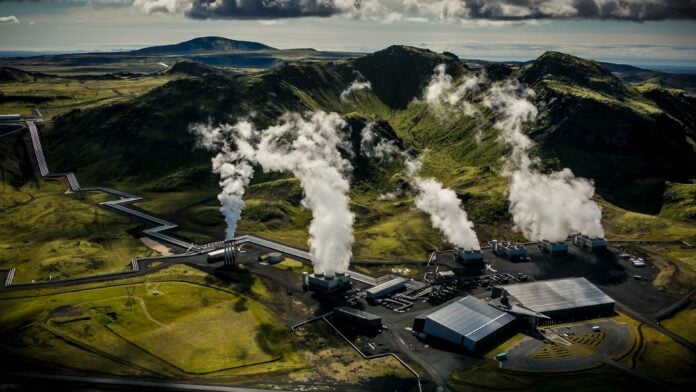Lauded as the world’s largest operational system for carbon capture and storage, the Orca plant in Iceland has been up and running since 8 September 2021.
Named for the Icelandic word ‘orka’ meaning ‘energy’, the plant combines the capture of carbon dioxide (CO2) from the atmosphere, facilitated by the Swiss start-up Climeworks AG, and its storage deep underground by the Icelandic start-up CarbFix, led by CEO Dr Edda Sif Aradóttir.
As the UNESCO Science Report (2021) explains, this process relies on research published in 2016, when scientists from Australia, Denmark, France, Iceland, the UK and USA reported a successful attempt to dispose of CO2 permanently as environmentally benign carbonate minerals in subsurface basaltic rocks (Matter et al., 2016). Within two years, 95% of the anthropogenic CO2 injected in a storage formation was mineralized, contradicting the prevailing view that such a process would take up to 1 000 years (Hertig et al., 2021; Box 11.2).
CarbFix method
The report relates how the successful pilot project was run at the CarbFix injection site near Reykjavik. Massive volumes of ‘sour gas’ emissions containing high levels of contaminants such as carbon dioxide and hydrogen sulphide were captured after being released together with geothermal fluids from the Hellisheidi power plant. These emissions were then mixed with water and pumped back from whence they came.
This technique has since become commonplace. The CarbFix method is used to clean and store underground one-third of the annual 40 000 tonnes of CO2 flowing through gas turbines. Through the same process, two-thirds of the released hydrogen sulphide are also safely deposited in the subsurface.
CarbFix will not solve the world’s problem of greenhouse gas emissions, of course. One severe limitation of the method described above is the need for substantial quantities of water and the presence of porous basaltic rock. Both are widely available on the continental margins, such as in Iceland and the Pacific Northwest of the USA, but are rare or absent in other parts of the world.
Cost is a barrier
The cost of carbon capture and storage is another barrier. The Orca plant cost US$ 10–15 million to build and could draw down 4 000 tonnes of CO2 each year when operating at full capacity. To put that number into context, this is equivalent to the emissions from about 870 cars, according to the US Environmental Protection Agency.
Climeworks aims to reach a carbon offset purchase price of $200–300 per tonne of CO2 by 2030 and $100 to $200 by the mid-2030s, once fully operational (Sigurdardottir and Rathi, 2021). With European carbon prices at about US$ 50 per ton of CO2 equivalent under the European Union Emissions Trading Scheme , the penalty for emitting could soon exceed the cost of carbon capture.
Progress in this field will call for a close partnership between science, technology and industry. CarbFix itself is the brainchild of four institutions: Reykjavik Energy, the University of Iceland, the National Centre for Scientific Research in Toulouse (France) and Columbia University (USA).
Despite these advances, the high-tech industry of carbon capture and storage is still in its infancy. All of the pathways defined by the Intergovernmental Panel on Climate Change for limiting global warming to 1.5°C rely on technological advances in CO2 removal from the atmosphere to augment the natural process of carbon sequestration (IPCC, 2018). However, research output on carbon capture and storage has one of the lowest growth rates (6% between 2011 and 2019) among 56 sustainability topics studied by UNESCO, with a mere 2 501 publications on this topic produced around the world in 2019 (Straza and Schneegans, 2021).
(Source: UNESCO see here)







